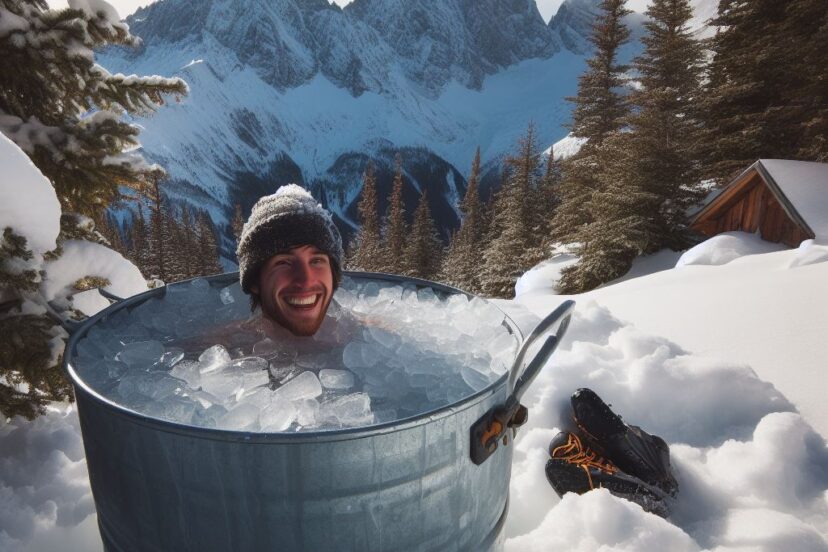Ice Bath Temperature: Cool Depths of Wellness
*We may earn a commission for purchases made using our links. Please see our disclosure to learn more.
Ice Bath Temperature: Optimal Ranges for Recovery and Health Benefits
Ice baths have become a staple in many athletes’ recovery routines, and there’s a growing interest in their potential benefits. As someone who has spent a considerable amount of time understanding and engaging with this recovery method, I can confidently say that while the practice might appear daunting, it’s grounded in a scientific approach to reducing inflammation and speeding up muscle recovery. The ideal temperature range for an ice bath typically falls between 50 and 59 degrees Fahrenheit (10-15 degrees Celsius). This range is carefully chosen to ensure that the water is cold enough to constrict blood vessels and reduce swelling, without being so cold as to pose a risk for hypothermia or frostbite.

For newcomers to cold water immersion, it’s advisable to start at the warmer end of the spectrum and gradually work towards colder temperatures. This gradual adaptation helps in acclimating the body to the cold and can mitigate some of the risks associated with ice baths. The time spent in an ice bath is another critical factor, and while guidelines vary, a common recommendation is to limit immersions to ten to fifteen minutes.
Aside from recovery, some individuals use ice baths for performance enhancement, where a slightly higher temperature might be suggested, such as 15-20 degrees Celsius (59-68 degrees Fahrenheit). Despite the perceived benefits, ice baths are not without their risks. It’s important to listen to one’s body and ensure that the practice is done safely, with attention to any warning signs that might indicate a negative reaction. In my experience and research, ensuring a controlled environment and understanding one’s personal limits are key to harnessing the potential benefits of ice baths while minimizing risks.
Understanding Ice Bath Fundamentals

In exploring the essentials of ice baths, it is crucial to consider the scientific principles behind cold exposure and the specific role of water temperature in optimizing the practice for health and recovery benefits.
The Science of Cold Exposure
When I submerge myself in cold water, my body experiences vasoconstriction, which is the narrowing of blood vessels. This physiological response reduces blood flow to the surface of the skin and redirects it to the core organs, which can help in decreasing inflammation and swelling. Cold therapy, an umbrella term that includes ice baths, capitalizes on this response. It works on the principle that the exposure to cold can help in managing pain and improve recovery by affecting the body’s circulation.
Role of Water Temperature in Ice Baths
The water temperature in an ice bath is not about braving the coldest temperature I can tolerate; instead, it’s about finding an effective range that stimulates vasoconstriction without posing health risks. Research and anecdotal evidence suggest that a water temperature between 50-59°F (10-15°C) is generally viewed as optimal for ice baths. This range is cold enough to trigger the therapeutic effects but is usually safe enough to reduce the risks of hypothermia or frostbite.
- Optimal Water Temperature: 50-59°F (10-15°C)
- Duration: Start with 2-5 minutes, potentially increasing as I become accustomed
When I practice ice baths within this temperature range, it allows for a controlled environment where the benefits of cold exposure can be experienced safely. Maintaining the ideal temperature and duration is critical to maximize the benefits of vasoconstriction and improved blood flow for recovery and performance enhancement.
Optimizing Ice Bath Temperatures

In determining ice bath temperatures, I balance efficacy with safety, prioritizing optimal temperature ranges and durations tuned to individual tolerance levels.
Determining the Ideal Temperature Range
To experience the benefits of cold therapy without risking harm, I found the ideal temperature range for an ice bath is 50 to 59 degrees Fahrenheit (10-15 degrees Celsius). This range is effective for reducing inflammation and aiding muscle recovery. However, temperatures should not fall so low that they pose a threat of hypothermia. I learned that healthcare providers can offer guidance on safe practices, particularly when considering an individual’s health and their core body temperature management.
Adjusting Ice Bath Duration for Maximum Benefit
The duration in the ice bath is just as crucial as the temperature. I adhere to sessions between 2 to 5 minutes. This is sufficient time for the body to receive the cold therapy’s benefits without causing negative reactions such as frostbite. Adjusting the duration to be shorter or slightly longer can be done in response to my cold tolerance and the particular recovery or performance goals I have set for myself.
Benefits of Regular Ice Bath Use

I find that incorporating regular ice baths into my recovery routine can offer significant benefits. Specifically, these benefits range from physical effects such as reduced inflammation and soreness to psychological effects including enhanced mood and mental clarity. In the subsections below, I’ll detail the advantages of cold immersion therapy which have been well-supported by both research and anecdotal evidence.
Reducing Inflammation and Soreness
Inflammation: It’s a common response to muscle damage from intense workouts. Ice baths, by rapidly cooling the body, can lead to constriction of blood vessels, which helps decrease inflammation and the resultant soreness.
- Pain Relief: The cold temperature numbs nerve endings, providing immediate relief from muscle pain.
- Reduced Inflammation: Regular use of ice baths can help maintain lower levels of inflammation in the body post-exercise.
Enhancing Muscle and Exercise Recovery
Muscle Recovery: Submerging myself in cold water after strenuous exercise has a profound effect on accelerating muscle recovery by reducing the metabolic rate and slowing down physiological processes.
- Immediate Impact: The cold immersion constricts blood vessels and decreases metabolic activity, which lessens the swelling and tissue breakdown.
- Long-term Recovery: Over time, regular cold therapy can improve my overall exercise recovery and performance.
Psychological Advantages of Cold Immersion
The mental benefits of ice baths are not as frequently discussed as the physical ones, but they’re equally impressive.
- Mental Clarity: Cold exposure can enhance mental clarity and focus, likely because of the reduced inflammation in the body.
- Mood and Relaxation: The release of endorphins during and after an ice bath may lead to improved mood and a sense of relaxation.
- Alertness: The initial shock and subsequent adaptation to cold water can help increase alertness and invigorate my senses.
Practical Guidelines for Ice Bath Therapy

Engaging in ice bath therapy requires careful planning and adherence to safety protocols. I’m here to guide you through these steps to maximize the therapy’s benefits while ensuring your well-being.
Preparing for an Ice Bath
Preparing for an ice bath is crucial to making the experience effective and safe. I ensure I have all necessary items on hand:
- Ice: Depending on the size of the bath, I use a sufficient amount of ice to reach a therapeutic temperature between 50 to 59 degrees Fahrenheit.
- Chiller (Optional): For a more controlled environment, a chiller can maintain the desired temperature without continuous monitoring.
- Waterproof Thermometer: It’s vital for me to monitor the water temperature accurately. Thus, a waterproof thermometer should be used to ensure it remains within the safe range.
- Suitable Container: I choose a container that is large enough to accommodate me and the water needed, such as a tub or portable ice bath.
Step-by-Step Approach:
- Fill the Container: I fill my chosen container with cold water.
- Temperature Adjustment: Gradually, I add ice or use a chiller to decrease the temperature while monitoring it with the thermometer.
- Safety Gear: I sometimes wear neoprene booties and gloves to protect my extremities from the cold and reduce the risk of frostbite.
Before I step in, I make sure all preparations are complete. It’s important for me to feel mentally prepared for the cold shock and to ensure I’m not alone in case I need assistance.
Safety Precautions and When to Avoid Ice Baths
Safety is paramount when it comes to ice bath therapy. Here are the precautions I adhere to:
- I never exceed a total immersion time of 10 minutes, starting with only 2-5 minutes if I am a beginner.
- I avoid submerging my head or neck to prevent the risk of cold-induced spasms or difficulty breathing.
- I immediately exit the bath if I experience unbearable pain, discomfort, or numbness.
Health Precautions:
- I avoid ice baths if I have a heart condition, high blood pressure, or any condition that affects my body’s response to cold.
- I steer clear of ice baths after consuming alcohol.
When to Avoid Ice Baths:
If I’m pregnant, have Raynaud’s phenomenon, or an open wound, I know that ice baths are not safe for me and I avoid them. Additionally, I consult with a healthcare provider before starting ice bath therapy, especially if I have any underlying health issues.
Addressing Potential Risks and Considerations

Before submerging into an ice bath, I consider both the potential benefits and risks. My goal is to ensure safety and effectiveness in cold therapy practices.
Understanding and Mitigating Health Risks
When I recommend ice baths to individuals, my primary concern is the minimization of health risks. Two significant dangers are hypothermia and frostbite, conditions that arise when the body is exposed to extremely cold temperatures. Symptoms like numbness or skin color changes signal that it’s time to exit the water to prevent tissue damage.
To mitigate these risks, I advise:
- Time Limits: A maximum of 2-5 minutes in the ice bath.
- Temperature: Keeping the water between 50-59°F (10-15°C).
Individuals with high blood pressure or a heart condition should consult their healthcare provider before trying an ice bath, as the shock of cold water can increase cardiovascular strain.
Navigating Individual Variations in Cold Therapy
I recognize that no one-size-fits-all approach exists for ice baths due to individual preferences and health status variations. Some may prefer slightly warmer temperatures, while others can tolerate the colder end.
Here’s a brief outline of how I navigate these variations:
- Initial Temperature: Start at 59°F (15°C) and gradually lower if tolerated.
- Monitor Responses: Look for signs of discomfort or distress, such as intense shivering or pain.
- Check History: Assess for past experiences of tissue damage from cold exposure.
Always consult a healthcare provider to tailor the cold therapy to personal health profiles, ensuring safety and optimizing recovery.
Frequently Asked Questions
In this section, I cover some of the most common inquiries about ice baths, such as duration, temperature limits, benefits, and specific guidelines for athletes.
1. What is the recommended time duration for an ice bath?
Typically, I would suggest staying in an ice bath for 2-5 minutes. This duration is sufficient to constrict blood vessels and minimize muscle inflammation without overstressing the body.
2. At what temperature does an ice bath become too cold for safety?
I advise against using an ice bath colder than 50 degrees Fahrenheit (10 degrees Celsius). Temperatures lower than this increase the risk of hypothermia and frostbite.
3. What are the benefits of taking an ice bath?
Taking an ice bath can help reduce muscle inflammation, ease soreness, and accelerate recovery. It’s also known to help with the constriction of blood vessels, which flushes out metabolic waste post-exercise.
4. What is the ideal temperature for an ice bath for athletes?
For athletes, I recommend an ice bath temperature between 50-59 degrees Fahrenheit (10-15 degrees Celsius). This range is optimal for recovery while minimizing discomfort and risk.
5. How long should one remain in a cold plunge for effective results?
Staying in a cold plunge for about 2-5 minutes is usually the most effective. It’s long enough to provide therapeutic benefits without causing harm to the body.




